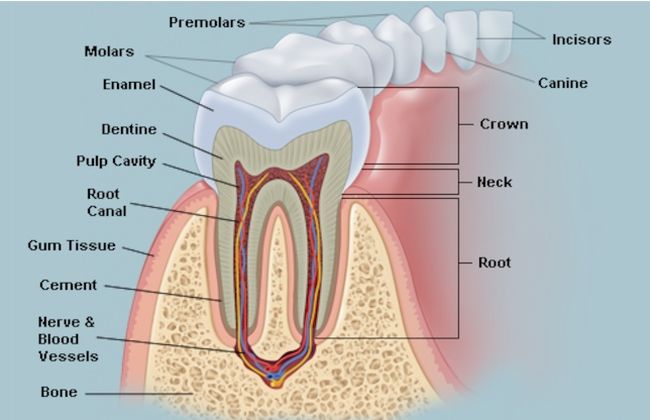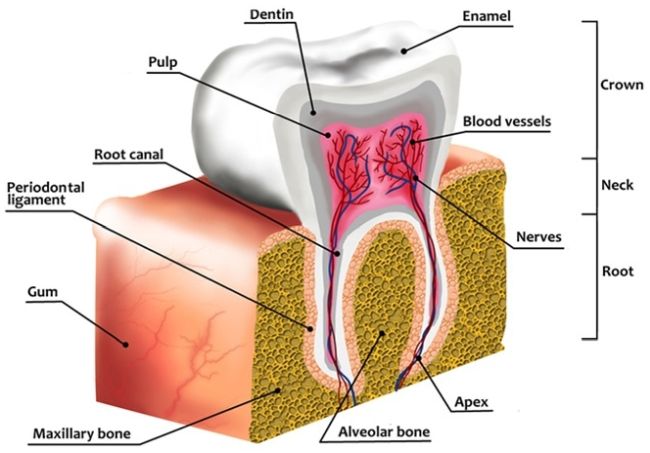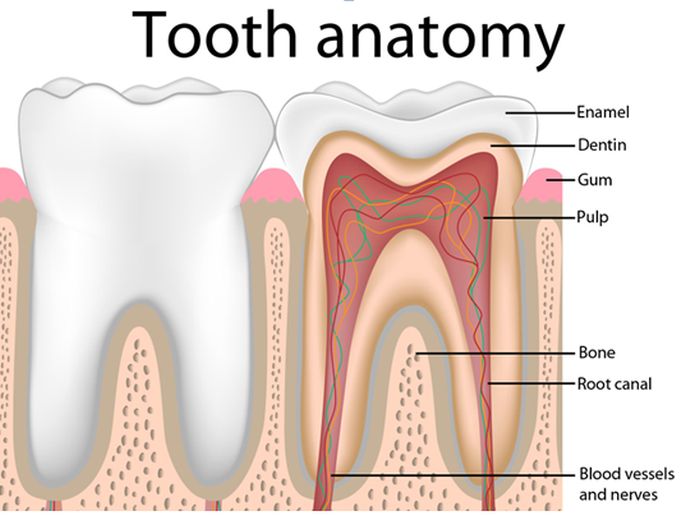Human teeth have specific functions, among them, we can mention phonetic functions for when we speak, mechanical functions for when we eat, and an aesthetical function since they provide our face with correct vertical proportions and when we talk and smile our teeth give us a pleasing appearance.
When we eat, our teeth are the ones that break down what we’re chewing, by crushing and cutting them so that we can swallow them and the digestion process can happen effectively.

Humans have four types of teeth; incisors, canines, premolars and molars, all of them have a specific job to do. Incisors have a sharp edge to help cut the food, canines tear the food and premolars and molars are there to crush and grind the food.
Every tooth has a long and strong root that is embedded in the bone; in the upper jaw that bone is called maxilla and in the lower jaw it is called mandible. The roots and a small portion of the tooth are covered by your gums.
Teeth are made up of different tissues, and they vary on hardness and density. Teeth are one of the most easily recognizable features of any mammal species, and they last for a very long time since it is very difficult for teeth to degrade and it can take many, many years to do so.
Humans, like several other types of mammals, are diphyodont, and this means that they develop two sets of teeth in their life. A set of “baby teeth” or deciduous teeth, and a set of permanent teeth.
https://www.youtube.com/watch?v=Y0BfmKkFsA0
What are teeth made of?
Like we said before, teeth are made up of different types of tissues, and they vary in hardness and density.

Enamel:
- Enamel is the hardest and the most highly mineralized substance in the human body. Around 95% of the composition of enamel is made up of minerals, while the other 5% is water and organic material. It comprises the outer layer of the tooth, above the dentin, which is right underneath it.
- The natural color of enamel varies; it can go from a light yellow to a grayish white. It is semitranslucent, so the color of the dentin underneath it or any restorative material will affect the color of the tooth.
- The primary mineral that makes up the enamel is called hydroxyapatite; a crystalline calcium phosphate. While this is a very hard substance, it is also quite brittle, so the underlying dentin is also there to give it support.
Dentin:
- Dentin is the tissue that goes between the enamel and the pulp chamber. It is also quite hard, but not as much as enamel and it is very porous. It decays faster than enamel because of these characteristics.
- It has microscopic holes in them that are known as dentinal tubules, that go from the pulp and reach the enamel or cementum (depending on the part of the tooth).
Cementum:
- This part of the tooth is quite similar to bone in appearance and it covers the root portion of the tooth. It has a yellowish color and it is softer than dentin. Its job is to serve as a medium so that the periodontal ligaments attach to the tooth.
- There are two types of cementum; cellular and acellular. The former covers about 1/3 of the tooth and it is located at the apex of the root. The latter cover the other 2/3 of the roots and it lacks cellular components.
Dental pulp:
This is the center of the tooth and it contains soft connective tissue; blood vessels and nerves. Other types of cells found in the pulp are fibroblasts, macrophages, preodontoblasts, and T lymphocytes.

